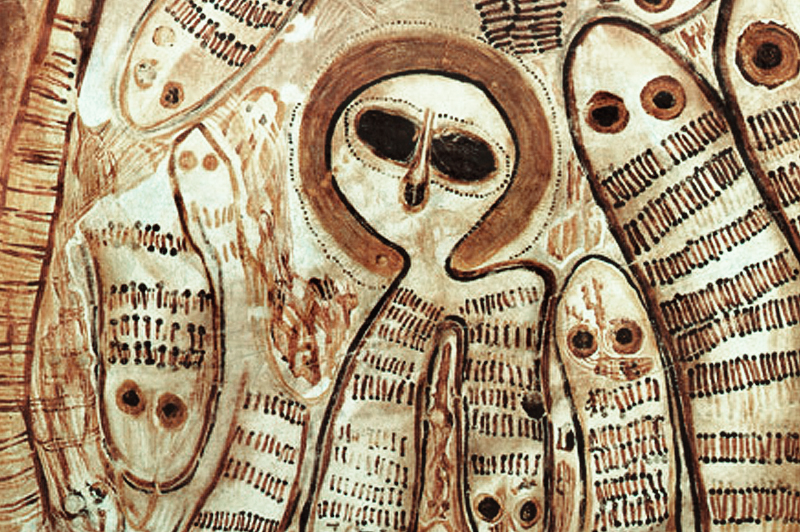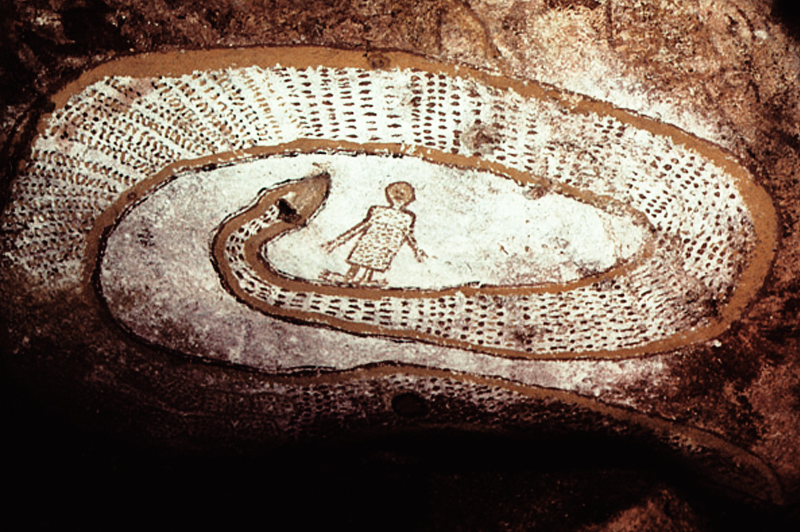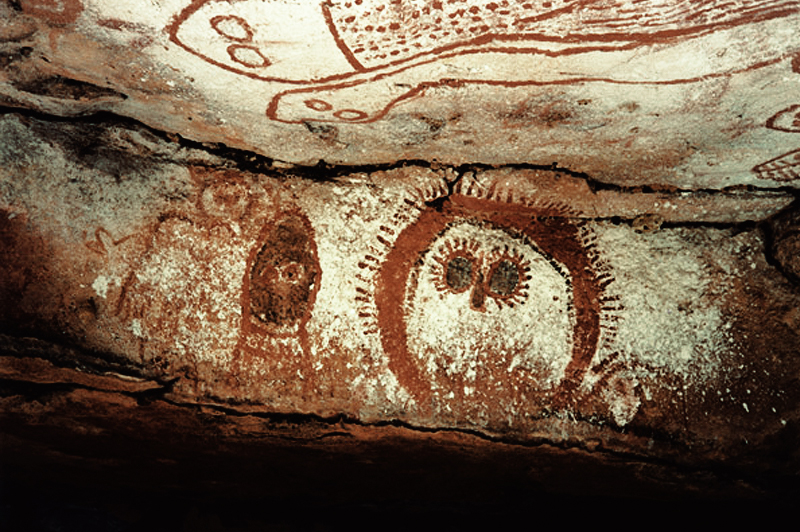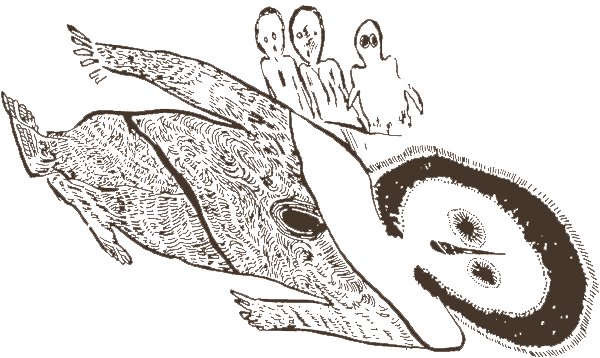


In 1938 Doctor Andreas Lommel, a member of the Frobenius Institute, lived for several months in the Outback of north-western Australia in a region called Kimberley, with the Aboriginal Peoples named Unambal. During this time he recorded and photographed the daily life of a hunter-gatherer culture.

Buster was the resident policeman of Fitzroy Crossing, a one-horse town in Kimberley, north-western Australia. With two Aboriginal trackers, the four of us were on the last mounted police patrol, a 700 mile ride on mules visiting some of the Cattle Stations north of the King Leopold Range. Gibb River Station was our most northern destination and we had come to check up on the activities of two German archaeologists, Andreas and Katharina Lommel.
Katharina was an artist, and her job was to trace the Wandjina paintings on the walls of the sacred Aboriginal site, and then copy them onto canvas and reproduce the original colours. In 1955 there was no colour photography. Her paintings can still be seen in the Munich Natural History Museum.
Translated extracts from Dr Lommel’s publication ‘Die Kunst des alten Australien’, recording the time he lived with a north-western Australian Aboriginal Tribe in 1938, follow below:

The Australian Aboriginal Peoples lived in two times only: the primeval times, in which all life came into being, and the present. There is no future. Their language has numerals for ‘one’, ‘two’, and ‘three’ but the word for ‘four’ is the same as ‘very many’.
The Wandjina are divided into two groups; the originators of all human customs and the inventors of all implements. The Wandjina can change from one form to another at will; from a Wandjina, to a w a human, to an animal. The Wandjina live today at the bottom of the ‘watering place’ associated with each particular painting. According to the Aboriginal People, when the Wandjina lay down, they entered the earth, leaving their imprints on the stone, so they were believed to be the originators of the rock paintings.
Another version of the creation of the paintings is that little birds named ‘Kujon’ created them at the Wandjina's request, with blood from their own wounded beaks. No one has ever seen the birds painting, but it is believed to be true. The birds also painted the human figures, named Bradshaw Paintings, on the rocks but these have no connection with the Wandjina paintings, although they are often found in the same rock shelters.
The oldest man in the hunting group has the task of re-painting the Wandjina before every Monsoon. When he is finished the artist fills his mouth with water and blows it over the painting, because in ancient times the Wandjina blew the rain over the land in this way. The Wandjina have no mouths so they make a noise that sounds like thunder. When the Wandjina want the rain to stop they become rainbows so the world will not flood. If a Wandjina fails to make rain the old man returns to the painting and throws stones at it, or defaces the nose.






The Aboriginal People believe the act of procreation is of only slight significance for their entry into life, although they are in no doubt at all about this physical function in the case of animals. In their view, spirit children split off from the Wandjina and then live in the depth of the water with them. Only through a dream process can a man acquire such a spirit child. A further dream process is necessary to transmit the spirit child to the man's wife. The spirit child is about the size of a finger, and when the father finds one he can bind it into his hair and carry it around with him for years.

A child's sex is known from the moment the spirit child is found, but at the moment of birth its sex can be changed. The Aboriginal People stick a club upright in the sand beside the woman giving birth if they want a boy or a cleft digging stick if they prefer a girl. After birth the umbilical cord is hung around the child's neck and must not be lost, otherwise the child would die. The child is then washed and fine charcoal dust is rubbed into its skin to make it black. When a person dies the spirit child returns to the Wandjina's watering place where it was found in a dream by the father.
Besides the spirit child, each person also has a series of others souls or shadows. After death one of the shadows goes to an Underworld, in which life proceeds as it does on Earth. A connection is possible between a living person on the Earth and the shadows in the Underworld. Contact with the shadows of the Underworld is the function on the Medicine Man, who is a central figure of importance in the lives of the Aboriginal People.
Medicine men are at the centre of the community and life among the aboriginal People comes to an end if he dies or he loses his skills. He is the collective soul of the hunting group, and his job is to make good all that is not as it should be. From a biological viewpoint, the Aboriginal Peoples’ whole life is considerably more strongly influenced by the ‘psyche’ than it appears to be in Western Man's case. He is their link with primeval times and the Creation, and without him a complete degeneration of their order and life occurs. Life in the present is only possible through constant contact with primeval times. The mediator between the present and primeval times is the Medicine Man, as he not only lives in the present, but in him the creative forces that were in operation in primeval times are still alive today.
Through dreams the Medicine Man can establish contact with primeval forces. In a state of trance he separates his shadow from his body, and sends it to distant lands or the Underworld. Before the wet season starts the Medicine Man goes to the rock painting of the Wandjina to re-establish contact. He is also the only one who can associate safely with the rock spirits that eat the corpses and carry off people's souls. Finally it is the Medicine Man who can send his soul to the underworld, thus maintaining the link between the living and the ancestors.
It is the task of the Medicine Man to fill the Wandjina with renewed life, in this way to guarantee the rain for each year. This same power enables him also to heal sick people, ensure success in the hunt, or even kill people who prove to be a burden to the fellowship of the tribe. The Medicine Men are the poets of the tribal community, receiving the Corroboree (songs and dances) from the Underworld.

The realm of the shadows is in the West on a stony island, with plenty to eat and drink, which is very beautiful and always has a fresh wind blowing so is never too hot. To get there the shadow of the dead person climbs into the sky from the tree on which the corpse is lying, and goes to the land of the dead on a thin string. The journey takes one day.
In the realm of the dead it is dark at first. On arrival the soul sits down on a stone and looks around and then goes into the ground as if on steps. Beneath the earth it is bright, the dead moon shines there; there is also a great fire there, in the smoke of which the souls of arriving aborigines cleanse themselves. Immediately on arrival the souls of the departed rush to the new arrival and ask where it came from. The soul answers, at the same time calling its mother's name. The mother's soul forces its way through the crowd of aboriginal souls, looks at the newcomer and is glad to see him. The soul then gets smaller and smaller, sheds its feet on which it walked to the realm of the dead via the string in the sky, the feet become bats and remain hanging on the rocks.
The soul becomes so small that it fits into a bark carrier, which the mother soul then carries around with her for the same length of time as she carried her child in her body on earth. From the bark carrier the aboriginal soul is then born again, grows up and then lives forever in the realm of the dead.
The performance of a Corroboree is of enormous importance to the Aboriginal People. Corroboree is the name given by the Aboriginals to dances that are performed by song leaders, with the assistants of a chorus using rhythm sticks. The dancers are painted and adorned with feathers and clumps of leafy twigs.
There are many accounts of 200 dancers and 300 singers taking part in a Corroboree at one time. One song attended had 38 verses.
When moving through this region the Unambal Tribe travel by sea as far as possible. From south to north they first cross the Prince Regent River and then go to Harding Point, from where the journey by dugout canoe begins. The outgoing tide carries them to Lamarack Island, the incoming tide to Bigge. From there with the outgoing tide to Combe Hill and with the ebb tide to Prudoe Island. The incoming tide takes them to Tancred Island, and the next incoming tide to Cape Voltaire, where the Unambal territory comes to an end.
→ Subscribe free to the Bradshaw Foundation YouTube Channel
→ Australia Rock Art Index
→ Introduction to the Australia Rock Art Archive
→ Rock Art of the Kimberley
→ Rock Art Australia (RAA)
→ Dating the Rock Art of the Kimberley
→ Australia's Oldest Known Rock Art
→ Film - Griffith University's Laureate
→ ABC Radio National 'Nightlife'
→
Experts rush to map fire-hit rock art
→ The aftermath of fire damage to important rock art at the Baloon Cave tourist destination, Carnarvon Gorge, Queensland, Australia
→ Studying the Source of Dust
→ Rock Art of Western Arnhem Land
→ Australia's Aboriginal People
→ The Kimberley
→ Out in the Back Country - Hugh Brown
→ Bradshaw Foundation
→ Rock Art Network













